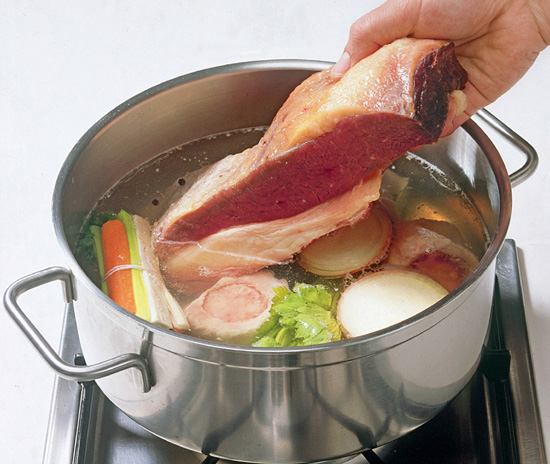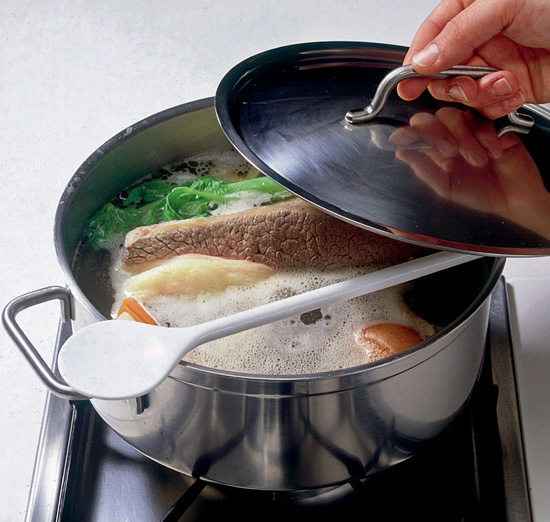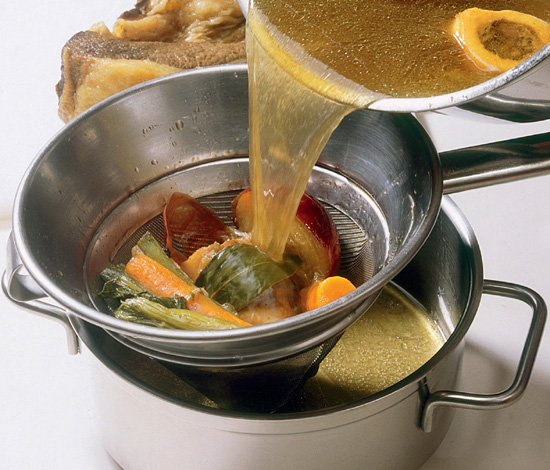Fresh herbs and scallions garnish clear soups perfectly.
Stock is a traditional kitchen staple, the by-product of other kitchen processes and the starting point for many soups. Boiling vegetables, meat, fish or poultry in water produces stock, as does boiling leftover bones, aromatic vegetables and spices.
A clear soup can be eaten with added chunks of meat, chopped vegetables, egg, noodles or dumplings. More substantial soups use stocks as a base but are thickened with a roux, cream, crème fraîche, sour cream or puréed vegetables. Purée or liquify the pan contents after cooking to create a smooth soup.
Use as large a saucepan as possible, as the ingredients must be able to float.
• For a simple meat broth, you need about 3–4 pound (400 g) beef or poultry, 2 carrots, 2 trimmed leeks, 1 onion and a stalk of celery, plus salt, pepper and a bay leaf. Simmer all the ingredients in 6 cups (1.5 L) water for 30–40 minutes.
• Cook noodles, barley or rice separately and add to the soup later or it will turn unappetizingly cloudy.
• Spices such as bay leaves, cloves and star anise are best wrapped in muslin, tied in a bag and hung in the pot while cooking to make it easier to remove them afterwards.
• If you want to eat the meat cooked in the soup, such as boiled beef or chicken, make sure the water is boiling before adding it.
• A little cognac or a dash of vinegar in the cooking water makes the meat in a soup especially tender.
To make a stock, you also need to add meat bones or fish bones and carcasses, if you can get them. You can also make a stock from a selection of vegetables.
• To make a light stock, for every 1 quart (1 L) water add about 11/2 pounds (750 g) chopped bones, a sliced onion, 1 bouquet garni, a carrot, a stalk of celery, a leek, a few peppercorns and a clove of garlic. Dice the vegetables, bring ingredients to a boil simmer on low for 4–5 hours before straining.
• For a dark stock, roast the bones and vegetables in the oven first.
• Stocks should simmer but never boil. That way, the stock is richer tasting and clearer. In addition, boiling for a long time causes the stock’s vitamins and minerals to go up in steam.
• Stock is ready when it has a concentrated aroma. If chicken bones were used, they should be falling apart.
• For a fish stock, mix 6 cups (1.5 L) water with about 2 cups (500 ml) dry white wine and add vegetables, salt, pepper, parsley and about 2 pounds (1 kg) lean white fish trimmings. Bring to a boil, reduce heat and simmer for 20 minutes. If you cook it any longer, it will become bitter.
While cooking soup or stock you will notice foam from congealed protein forming on the surface. Skim it off regularly, along with excess fat.
• Remove fat by skimming it or letting it soak into a paper towel. You can also let the liquid cool, then remove solidified fat from the top with a spoon.
• Clarify a finished stock by boiling a beaten egg white in it. The egg white absorbs suspended solids as it congeals—just strain the stock before you use it.
• You can also clarify stocks by straining them through a fine sieve or a piece of muslin.
• Add little or no salt to soups and stocks initially as they become more concentrated as liquid evaporates. It is best to add spices and seasoning carefully towards the end of cooking.
• Use only whole peppercorns in stocks. Ground pepper starts to taste bitter if cooked a long time.
• Use parsley stems for stocks—the flavor is stronger than in the leaves, which tend to turn bitter after lengthy cooking.
• Stocks or soups usually keep in the refrigerator for 2–3 days and can last up to 3 months in the freezer.
TOMATO SOUP is the perfect way TO USE UP a bounty of TOMATOES.
To make puréed soups, root vegetables, legumes, potatoes and squash or pumpkin are the best choices. The starchy ingredients combine with one another, making the soup nice and creamy. Add some curry paste to a puréed soup for a more intense flavor.
• For a puréed soup, soften about 1 pound (500 g) vegetables with 2 tablespoons (30 ml) olive oil then cook them together with the root vegetables, salt and pepper in 1 quart (1 L) water. Press the soup through a strainer or purée in a blender and season to taste.
• After braising the vegetables, cream soups can be thickened with 1–2 tablespoons (15–30 ml) flour and 1 cup (250 ml) cream, sour cream or crème fraîche.
• Thin too-thick soups with milk or a little water. Or thicken soups that are too thin with cornstarch made into a paste with milk or water.
• Puréed soups can be garnished with cream, butter, fresh herbs, croutons or crumbled bacon, or finish them with a swirl of plain yogurt.
• When preparing a cream soup, start by making the roux (see here), then whisk in the stock a little at a time so that no lumps form.
• To stop a cream soup from curdling, boil acidic ingredients such as tomatoes well. Then make sure you pour the soup into the cooking pan containing the cream, rather than the other way around.
• Finish a minestrone or other clear soup with freshly grated Parmesan and croutons.
• For a semi-smooth texture, process or liquify a soup mixture with a series of quick pulses.
Meat stock

1 Cover the washed vegetables, spices and meat with cold water.

2 Bring the stock to a boil and simmer for a while. Insert a spoon between the pot and the lid to let the steam out.

3 When the cooking is done, remove the meat and pour the contents of the pot through a strainer and into a second pot.